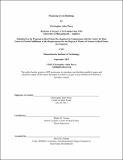Financing green buildings
Author(s)
Pierce, Christopher John, S.M. Massachusetts Institute of Technology
DownloadFull printable version (15.14Mb)
Other Contributors
Massachusetts Institute of Technology. Center for Real Estate. Program in Real Estate Development.
Advisor
Walter N. Torous.
Terms of use
Metadata
Show full item recordAbstract
An emerging trend in real estate is the development of sustainable buildings, partially due to the huge environmental impact of the design, construction and operation of commercial buildings. This thesis provides a brief history of the green building movement and the two (2) programs that encourage the development of energy-efficient and sustainable buildings in the United States: the U. S. Green Building Council's Leadership in Energy and Environmental Design (LEED) program and the Energy Star program, jointly sponsored by the Department of Energy and the Environmental Protection Agency. This thesis also summarizes a study by Piet Eichholtz, Nils Kok and John Quigley titled "Doing Well by Doing Good? Green Office Buildings" published December 2010 in the American Economic Review. This study found a commercial building with an Energy Star rating will rent for three percent (3%) more per square foot. The addition to effective rent was approximately seven percent (7%). The increase in value for a sale of a green building was as much as sixteen percent (16%). Then, using the same data as Eichholtz, Kok and Quigley, this thesis reports on the location and ownership of these green buildings, and calculates Loan to Value (LTV) ratios using the most recent sales price and financing amounts from the CoStar Group. In addition, the property's current LEED certification status is provided as well as a review of Federal and State incentives for sustainable buildings. The results indicate that more green buildings are located in California, Texas and Colorado. Investment Management firms, National Developer/Owners and Real Estate Investment Trusts own the majority of green properties. The Loan to Value (LTV) ratio for green buildings is no higher than those for conventional office buildings. Not enough information is available to compare mortgage interest rates between green and conventional properties. The number of LEED buildings and level of certification has increased since 2008. The states with the largest number of LEED buildings are California, Texas, Colorado and Virginia, correlating with the top states for green buildings overall. Although a worthy goal, there is limited Federal and State assistance for financing of sustainable buildings.
Description
Thesis (S.M. in Real Estate Development)--Massachusetts Institute of Technology, Program in Real Estate Development in Conjunction with the Center for Real Estate, 2013. This electronic version was submitted by the student author. The certified thesis is available in the Institute Archives and Special Collections. Appendixes are printed landscape orientation. Cataloged from student-submitted PDF version of thesis. Includes bibliographical references (pages 50-51).
Date issued
2013Department
Massachusetts Institute of Technology. Center for Real Estate. Program in Real Estate Development.; Massachusetts Institute of Technology. Center for Real EstatePublisher
Massachusetts Institute of Technology
Keywords
Center for Real Estate. Program in Real Estate Development.